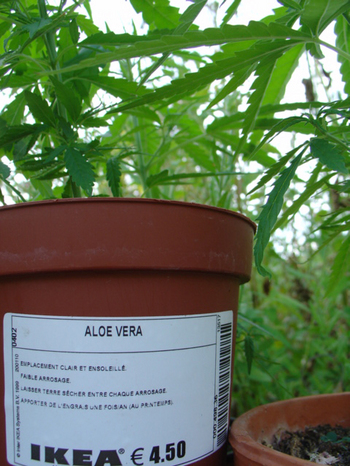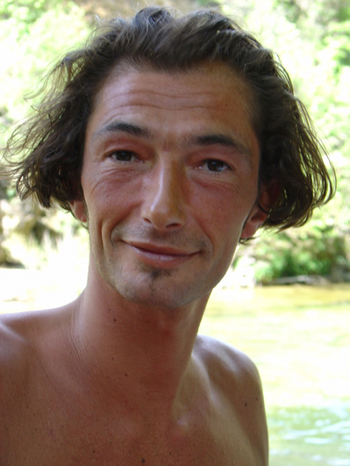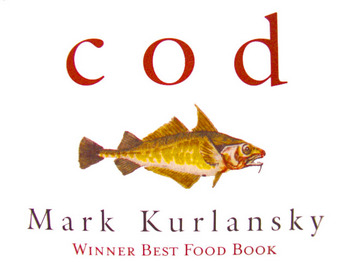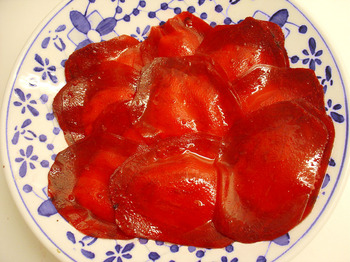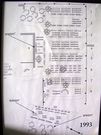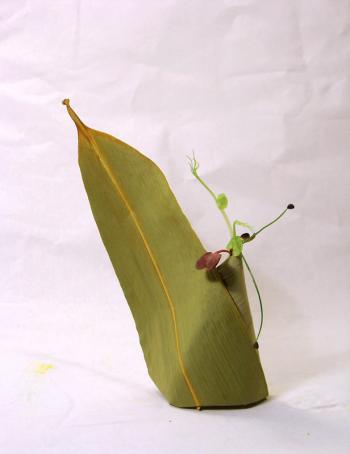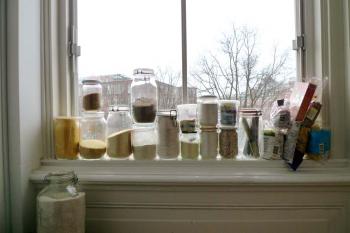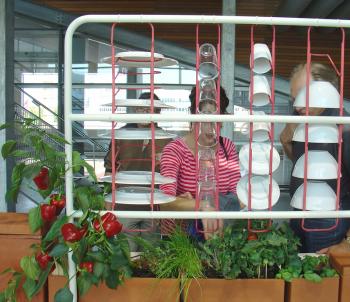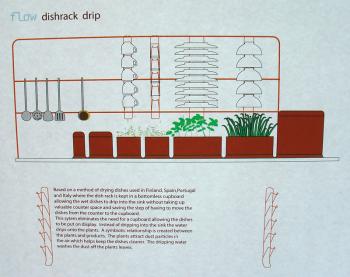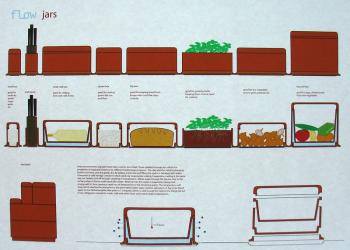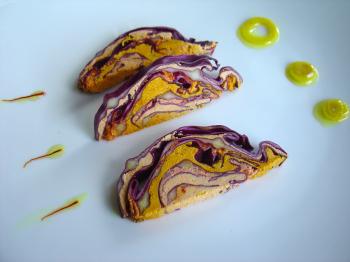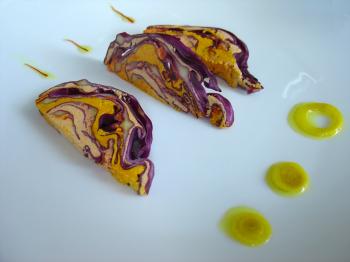John Arndt’s
Kitchen of Terrestrial Mechanics
June 29, 2006
If Mother Nature had designed a kitchen…
The Kitchen of Terrestrial Mechanics uses natural phenomenon normally taken for granted like gravity, evaporation, plant growth, static electricity, decomposition and digestion as mechanical elements in a holistic kitchen design. Water dripping off freshly cleaned dishes falls like raindrops onto the herbs growing below the dish rack. Unglazed ceramic food containers become cooler when they get wet from the drops of water from freshly washed dishes above. The water evaporates, cooling the interior of the container. Composted material is thrown into a garbage disposal governed by worms, to be turned into the rich castings that will grow the next month’s fresh herbs all over again. Nature’s mechanisms are integrated to create a flow of process uncommon in conventional kitchens.
In fact ‘Flow’ is the name Arndt gave to the family of products that work best as parts of the larger system. For the kitchen to work for you, you must use it. This may be the only kitchen you will ever meet that actually depends upon you to feed it, water it, let it grow, harvest it, eat it, get it really dirty, create some garbage in it and wash it for it to function optimally. This may be the only kitchen you will ever meet that will miss you when you’re gone and will wilt if you go away on an extended holiday, hungering for your return. The Kitchen of Terrestrial Mechanics is definitely Nature at its most gratifying.
debra at 18:14 | Comments (0) | post to del.icio.us
Autistic chocolate
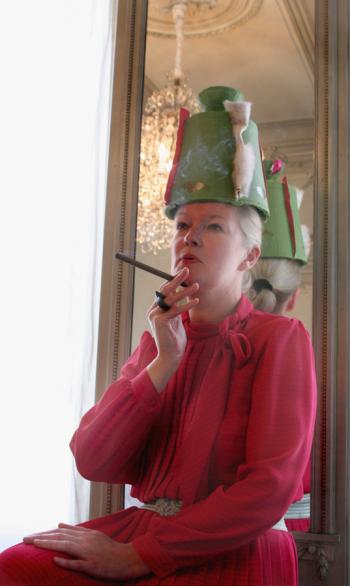
Chocolate hat © Ann de Gersem, photo C. Baele
A pink chocolate teapot hat? Pistachio green chocolate teacups with fur and pink foil? Dark chocolate whiskey snifter crystal ashtray bling? Ann de Gersem, a Design Academy Eindhoven MFA student graduates today with a collection of chocolate objects she designed in collaboration with the autistic employees of a Belgian chocolate factory. De Gersem, who isn’t autistic, wondered if the way autistics think could serve as a departure from conventional design methodology. Could autistic thinking lead to a new form of authenticity in design?
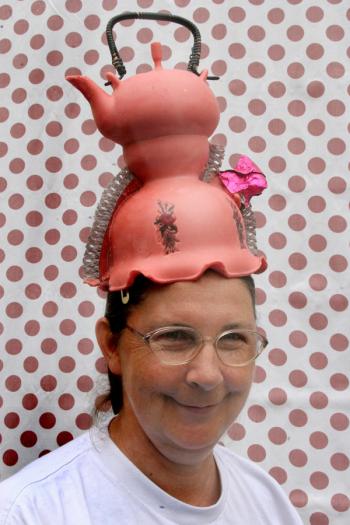
Chocolate hat © Ann de Gersem, photo C. Baele
De Gersem’s project, primarily the bit about designing within a culture that is not accepted as normative culture, the culture of autism, has broad implications. De Gersem’s Au(then)tism collection offers a visual language created in collaboration outside the culture of the neurologically typical. Writer, curator and activist, Ine Gevers wrote about this in 1999 in her essay, (En)countering the Culture of the Norm, for a one day seminar of the self-same title initiated by artist collective de Geuzen. Autists, according to Gevers, can be defined as those who are differently brained and whose language and/or (social) behavior deviates from the norm. By working with autistic people, de Gersem touches on the heart of what it means to design for ‘normative culture’ and therefore strikes at the heart of what is generally practiced as design.
Speaking of ‘normal’, normally designers graduate from design schools and get to work designing landfill as quick as you can say, ‘industrial designers should be more proactive in altering their practice of designing the Himalayas of waste’. But this is what I love about de Gersem’s approach. It’s not so much that her chocolate objects are ephemeral (discouraging the production, acquisition and accumulation of thingie-thingies), but that the method of their concepting and manufacture is designed to occur within the context of heterogeneity. In striving for authenticity, de Gersem embraces pure difference as a design technique. Design for differentnesss.
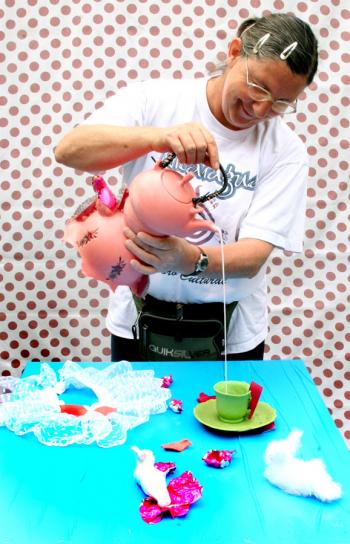
Frieda pours warm milk from a chocolate teapot © Ann de Gersem, photo C. Baele
Ine Gevers continues,
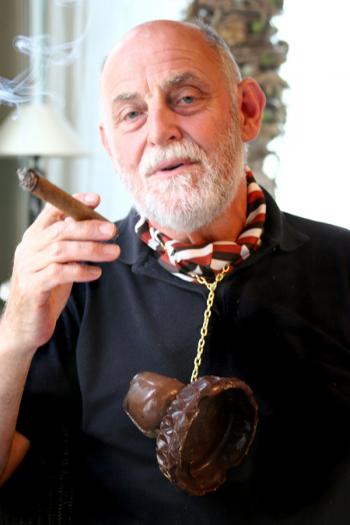
Dark and milk chocolate whiskey snifter ashtray bling © Ann de Gersem, photo C. Baele
So can we think of autsism as a culture? That’s a fiddly question! Read the front page of any newspaper anwhere at any time to smell the fetid disagreement about what a culture is or what should be its defining characteristics. The smartypants-hive-brain that is Wikipedia thinks thusly:
- … most cultural anthropologists as of 2006 define a culture as follows: (1) Culture is based on symbols, abstract ways of referring to and understanding ideas, objects, feelings, or behaviors -— and the ability to communicate with symbols using language. (2) Culture is shared. People in the same society share common behaviors and ways of thinking through culture. (3) Culture is learned. While people biologically inherit many physical traits and behavioral instincts, culture is socially inherited. A person must learn culture from other people in a society. (4) Culture is adaptive. People use culture to flexibly and quickly adjust to changes in the world around them. (Source: Encarta article on culture.)
According to these definitions, autistics are perhaps in the beginning stages of forming a real culture. Many features of what are commonly called cultures are visible in the autistic culture. There are shared beliefs, organisations, language, and art that are specific to the group, and there is a tendency to marry within the group. Autistic culture can be learned…
Amy Nelson (Aspies for Freedom) wrote a proposal on November 16, 2004 that the Autistic community are a social minority group and therefore should be considered as such by the United Nations.
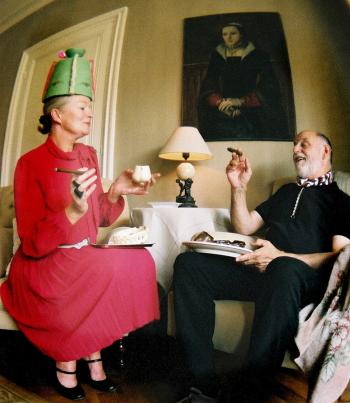
Nelly and Wies in the salon © Ann de Gersem, photo C. Baele
If you still think de Gersem’s work is about autistic people, why don’t you substitute the word ‘autistic’ in this entry for Kurdish or Palestinian or Kirghizian or Afro-American or Afro-Carribic or Islamic or Syrian Christian or Sikh or Chicano or even Anorexic and you will immediately understand that designing with and for subcultures is a really hot issue. The autistics must be nodding Mona Lisa smiles at the notion of being the poster-child of this positively radical (design) notion. What page of the Talmud was it that says, ‘Culture is difference’?
- Writer, curator and acitivist Ine Gevers writes about the culture of autism (1999) in an essay titled, (En)countering the Culture of the Norm.
- Ann de Gersem’s Life Dress in We-Make-Money-Not-Art
- Design Academy’s Fun Lab, initially an institute for studying the future of ‘fun’, is a postgraduate course in experience design.
- Jim sinclair: Autism is not an impenetrable wall
You try to relate to your autistic child, and the child doesn’t respond. He doesn’t see you; you can’t reach her; there’s no getting through. That’s the hardest thing to deal with, isn’t it? The only thing is, it isn’t true.
Look at it again: You try to relate as parent to child, using your own understanding of normal children, your own feelings about parenthood, your own experiences and intuitions about relationships. And the child doesn’t respond in any way you can recognize as being part of that system.That does not mean the child is incapable of relating at all. It only means you’re assuming a shared system, a shared understanding of signals and meanings, that the child in fact does not share. It’s as if you tried to have an intimate conversation with someone who has no comprehension of your language. Of course the person won’t understand what you’re talking about, won’t respond in the way you expect, and may well find the whole interaction confusing and unpleasant.
- From Wikipedia: The autism rights movement (which has also been called autistic self-advocacy movement [1] and autistic liberation movement [2]) was started by adult autistic individuals in order to advocate and demand tolerance for what they refer to as neurodiversity. The movement is supported by some neurotypicals including parents of autistic children. The movement is controversial and has been criticized by some parents of autistic children who disagree with its anti-cure and pro-neurodiversity views.
- Neurodiversity Weblog
- Online test at Neurodiversity dot com. (An Interactive Exercise in the Recognition of Emotions from Facial Expressions). Sadly, I didn’t do very well for a neurotypical person.
Your score to date
correct: 16 wrong: 13 hit rate: 55%
- And proving that autistics DO have a sense of humor, the Institute for the Neurologically Typical
debra at 1:20 | Comments (5) | post to del.icio.us
A recipe for Terrine Geologique
June 27, 2006
Although June is internationally recognised as the month of striation and I’ve been determined to pay hommage, I’m starting to feel like a 1980’s Romanian dictator, force-feeding nut-cheese recipes to her people. Maybe it’s because I’m feeling guilty about taking so long to write that entry about Ceaucescu, textured soy and the Romanian Otaku exhibition over at Mediamatic. Any day now. And after this one, I swear I mean I promise to stop with the nut cheese photographs. I’m just trying to be thorough.
Recipe after the jump. Vroom vroom!
(Please read more… )
debra at 23:17 | Comments (0) | post to del.icio.us

